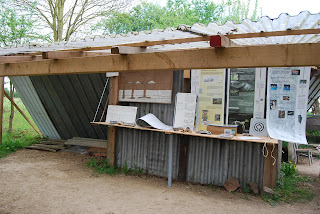*This article was published in WAB magazine's Summer issue. You can see the PDF at
http://www.scribd.com/doc/36997706/022-023-tourismfagnes
The Ardennes is an oasis. The region undisputedly has
the most breathtaking landscape in all of Belgium;
a network of lush rivers and streams, gorges and
verdant hills mounted by the trees that bulge at the
banks of the train tracks. It makes a nice change from the endless
farmland that blankets the rest of the country.
Where exactly is this water coming from? As I head towards
the small German-speaking town of Eupen on a train from
Brussels, I feel like I’m following the water. More creeks spring
forth. It’s a face of Belgium I hadn’t seen before.
I’m off to hike through the Hautes Fagnes (High Fens) nature
reserve. It is one of the largest wildlife sanctuaries in Belgium:
4,500 hectares of forest, heath, peat bogs and other wetlands.
The region also hosts part of the nation’s water supply, with
mineral springs, brooks and streams trickling over the years
through rich, mineral soil and eventually joining some of Belgium’s
biggest rivers.
After refuelling at one of Eupen’s many pavement cafés,
I catch a ride into the reserve. I am dropped off at the
Signal de Botrange, the highest point in all of Belgium
at a whopping 694 metres. Because of its altitude,
it’s generally where the first snow falls come
winter, and it’s my departure point today. The
Belgian Government even had a six-metre tower
built for people to climb and reach exactly 700
metres above sea level.
There is parking, a café and friendly information
desk. Just a few steps further on, the Nature Centre provides
guided tours or a place to leave your bags. The reserve is
lined with duckboards that make for easy walking and help to
protect the vegetation. Signposts are plentiful too. I cross the
highway and disappear into nature, breathing more easily as I
leave thoughts of the city behind.
I gaze out across a sprawling plateau. At this time of year it’s
flourishing and green. It is easy to imagine how the other seasons
treat the wetlands: the stark, austere colours of autumn
when the tussocks are dried out and golden; or in winter, when
the moors are dampened with snow, a blanket of quiet for
cross-country skiers keen to explore; or in spring when tufts of
cotton bloom and daffodils come alive.
The sound of grasshoppers ratcheting follows me around the
boardwalk, a constant companion. Sparse remains of cotton
and hare’s-tail dot the landscape. In the woods, I hear what I
imagine to be a woodpecker, though I see no sign of him.
The delicate eco-system of the Fagnes is supported by an
extremely wet climate and low-permeability subsoil. It rains,
on average, 170 days per year, with 76 snow days. When
there is too much water, the sponge-like earth is flooded and
the water swells to the surface, forming active peat bogs and
attracting an array of spectacular fauna.

As I continue, I see lizards sunning on the duckboards next
to ginger butterflies. Meadow pipits sing out as they dive and
drop in flight, and bumblebees are hard at work. I find bilberries,
and an abundance of tormentil.
It’s interesting to consider the influence of humans over
nature, when originally this land was home to woods alone.
The impact of man and his agricultural activities
has created a new eco-system; one that now needs
much protection and attention to keep the
peat bogs alive.
Exploring the High Fens:
• Look out for Baraque-Michel, a family hostel built in the early 19th century as a shelter
for weary or lost travellers. There is also the inn at Mont-Rigi, founded in 1862, which was
originally on Prussian turf. The two buildings also acted as customs posts.
• Marked crosses and stones were used as reference points in the early days to signify
land borders; many of these markers remain.
• Rent a bike and spend a day exploring the region at your own pace, weaving along a
multitude of signposted cycle tracks.
• Test your eyes and patience bird-watching – you might catch a glimpse























